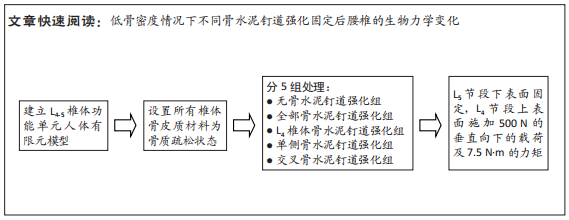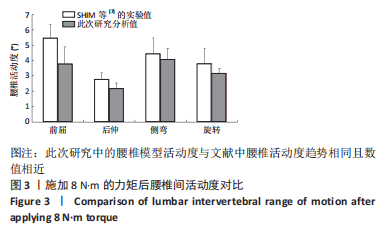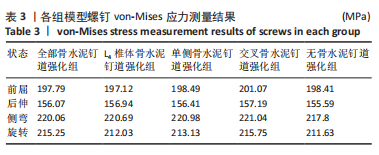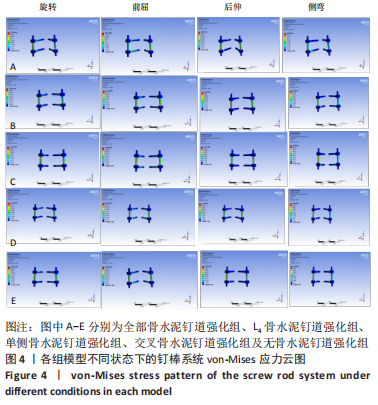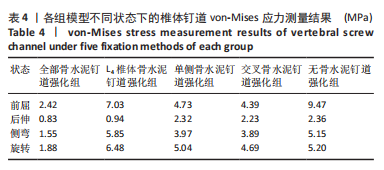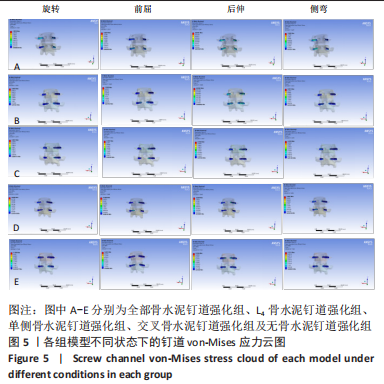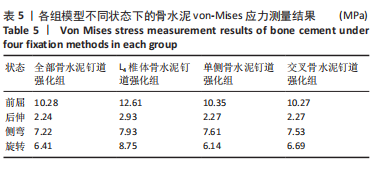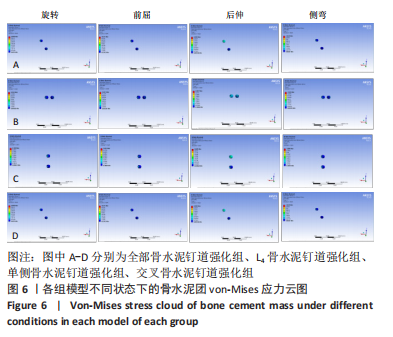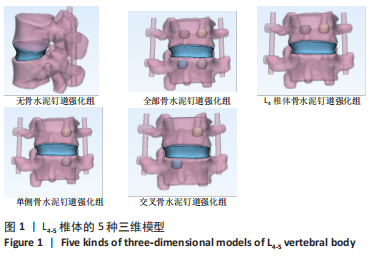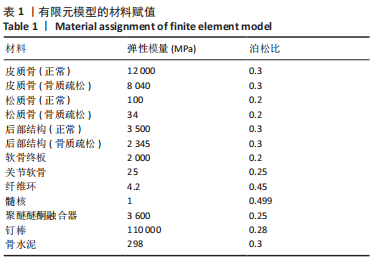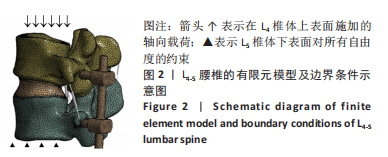[1] LANGDAHL BL. Overview of treatment approaches to osteoporosis. BRit J Pharmacol. 2021;178(9):1891-1906.
[2] DING H, HAI Y, LIU Y, et al. Cortical Trajectory Fixation Versus Traditional Pedicle-Screw Fixation in the Treatment of Lumbar Degenerative Patients with Osteoporosis: A Prospective Randomized Controlled Trial. Clin Interv Aging. 2022;17:175.
[3] HUANG D, YING J, XU D, et al. Comparison of percutaneous kyphoplasty with or without pedicle screw fixation in osteoporotic thoracolumbar vertebral fractures: a Retrospective Study. Dis Markers. 2021;2021:4745853.
[4] KANIS JA, COOPER C, RIZZOLI R, et al. European guidance for the diagnosis and management of osteoporosis in postmenopausal women. Osteoporosis Int. 2019;30(1):3-44.
[5] WANG Y, YANG L, LI C, et al. The Biomechanical Properties of Cement-Augmented Pedicle Screws for Osteoporotic Spines. Glob Spine J. 2022;12(2):323-332.
[6] PINTAR FA, YOGANANDAN N, MYERS T, et al. Biomechanical properties of human lumbar spine ligaments. J Biomech. 1992;25(11):1351-1356.
[7] SHIM CS, PARK S W, LEE SH, et al. Biomechanical evaluation of an interspinous stabilizing device, Locker. Spine J. 2008;33(22):E820-E827.
[8] YANG SC, LIU PH, TU YK. Pullout evaluation of sawbone experiment in different types of pedicle screws combined with bone cement augmentation for severe osteoporotic spine. Acta Bioeng Biomech. 2018;20(2):55-64.
[9] TANG YC, GUO HZ, GUO DQ, et al. Effect and potential risks of using multilevel cement-augmented pedicle screw fixation in osteoporotic spine with lumbar degenerative disease. BMC Musculoskel Dis. 2020; 21(1):274.
[10] CHEVALIER Y, MATSUURA M, KRÜGER S, et al. The effect of cement augmentation on pedicle screw fixation under various load cases: results from a combined experimental, micro-CT, and micro-finite element analysis. Bone Joint Res. 2021;10(12):797-806.
[11] HUANG H, ZHANG K, CHENG X, et al. Finite Element Analysis of Lumbar Interbody Fusion with Stent-Bone Granule-Absorbable Bone Cement. Int J Spine Surg. 2021:E184-E188.
[12] OSHTORY R, HARRIS JA, PATEL PD, et al. Lumbar intervertebral spacer with cement augmentation of endplates and integrated screws as a fixation device in an osteoporotic model: an in vitro kinematic and load-to-failure study. Int J Spine Surg. 2021;15(2):324-333.
[13] XIAO Q, ZHAO Y, QU Z, et al. Association Between Bone Cement Augmentation and New Vertebral Fractures in Patients with Osteoporotic Vertebral Compression Fractures: A Systematic Review and Meta-Analysis. World Neurosurg. 2021;153:98-108.e3.
[14] TAN JS, SINGH S, ZHU QA, et al. The effect of cement augmentation and extension of posterior instrumentation on stabilization and adjacent level effects in the elderly spine. Spine J. 2008;33(25):2728-2740.
[15] GUO HZ, TANG YC, GUO DQ, et al. The cement leakage in cement-augmented pedicle screw instrumentation in degenerative lumbosacral diseases: a retrospective analysis of 202 cases and 950 augmented pedicle screws. Eur Spine J. 2019;28(7):1661-1669.
[16] WILKES R, MACKINNON J, THOMAS W. Neurological deterioration after cement injection into a vertebral body. J Bone Joint Surg Br. 1994;76(1): 155-155.
[17] MILLS S, PIZONES J, RUEDA LRM, et al. Cardiac Cement Embolism After Thoracic Kyphoplasty: Successful Conservative Treatment With 4-Year Follow-Up. Int J Spine Surg. 2022;16(1):27-32.
[18] EL SAMAN A, MEIER S, SANDER A, et al. Reduced loosening rate and loss of correction following posterior stabilization with or without PMMA augmentation of pedicle screws in vertebral fractures in the elderly. Eur J Trauma Emerg Surg. 2013;39(5):455-460.
[19] KARLIN LI, MCCLUNG A, JOHNSTON CE, et al. The growth-friendly surgical treatment of scoliosis in children with osteogenesis imperfecta using distraction-based instrumentation. Spine Deformity. 2021;9(1): 263-274.
[20] 王鹏,王健,胡勇,等.下腰椎融合术后路单, 双侧椎弓根固定的有限元比较研究[J].中国临床解剖学杂志,2016,34(3):331-337.
[21] HÖCH A, SCHIMPF R, HAMMER N, et al. Biomechanical analysis of stiffness and fracture displacement after using PMMA-augmented sacroiliac screw fixation for sacrum fractures. Biomed Tech (Berl). 2017; 62(4):421-428.
[22] LIU YY, XIAO J, YIN X, et al. Clinical efficacy of bone cement-injectable cannulated pedicle screw short segment fixation for lumbar spondylolisthesis with osteoporosise. Sci Rep. 2020;10(1):3929.
[23] KANNO H, ONODA Y, HASHIMOTO K, et al. Innovation of Surgical Techniques for Screw Fixation in Patients with Osteoporotic Spine. J Clin Med. 2022;11(9):2577.
[24] LIU Z, LIANG H, SUN W, et al. Risk factors for local bone destruction progression in palliative percutaneous vertebroplasty for vertebral metastases and the significance of bone cement filling rates. Pain Physician. 2021;24(1):E101-e109.
[25] FAN J, LIU T, DONG X, et al. Effect of Zoledronic Acid on the Vertebral Body Bone Mineral Density After Instrumented Intervertebral Fusion in Postmenopausal Women With Osteoporosis. Glob Spine J. 2021: 21925682211027833.
[26] ZHANG W, LI L, ZHOU X, et al. Concurrent Treatment with Vitamin K2 and D3 on Spine Fusion in Patients with Osteoporosis-Associated Lumbar Degenerative Disorders. Spine J. 2022;47(4):352-360.
[27] TANI S, ISHIKAWA K, KUDO Y, et al. The effect of denosumab on pedicle screw fixation: a prospective 2-year longitudinal study using finite element analysis. J Orthop Surg Res. 2021;16(1):219.
[28] ZHANG Y, JIANG Y, ZOU D, et al. Therapeutics for enhancement of spinal fusion: A mini review. J Orthop Transl. 2021;31:73-79.
[29] WANG Z, ZHUANG C, CHEN W, et al. The Effect of Daily Teriparatide versus One-Time Annually Zoledronic Acid Administration After Transforaminal Lumbar Interbody Fusion in Osteoporotic Patients. Clin Interv Aging. 2021;16:1789.
[30] OTSUKI B, FUJIBAYASHI S, TANIDA S, et al. Possible association of pedicle screw diameter on pseudoarthrosis rate after transforaminal lumbar interbody fusion. World Neurosurg. 2021;150:e155-e161.
[31] SHIBUYA Y, KATSUMI K, OHASHI M, et al. Effect of adjuvant therapy with teriparatide in patients with thoracolumbar osteoporotic vertebral fractures who underwent vertebroplasty with posterior spinal fusion. Sci Rep-UK. 2022;12(1):1-8.
[32] SARDAR Z M, COURY JR, CERPA M, et al. Best practice guidelines for assessment and management of osteoporosis in adult patients undergoing elective spinal reconstruction. Spine J. 2022;47(2):128-135.
[33] HYAKKAN R, KANAYAMA M, TAKAHATA M, et al. Bone Metabolism in the Healing Process of Lumbar Interbody Fusion: Temporal Changes of Bone Turnover Markers. Spine J. 2021;46(23):1645-1652.
[34] 李黎,廖怀章.中药二仙汤治疗骨质疏松症的临床效果[J].临床合理用药杂志,2021,14(22):109-110.
[35] 张虎林,汪小敏,曹林忠,等.二仙汤联合椎弓根钉道骨水泥强化应用于骨质疏松伴腰椎管狭窄症的临床研究[J].时珍国医国药, 2020,31(8):1902-1904. |
